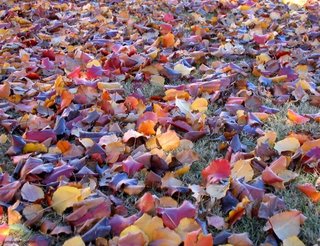 I thought I’d do a quick refresher course on leaves today, seeing as A and I will be busy all day Saturday raking. So, why do leaves turn color in autumn? I’ll tell you. (OK, so I actually stole the information from www.kidzone.com…)
I thought I’d do a quick refresher course on leaves today, seeing as A and I will be busy all day Saturday raking. So, why do leaves turn color in autumn? I’ll tell you. (OK, so I actually stole the information from www.kidzone.com…)Inside a leaf there are millions of little packages of color in green, yellow and orange. The green packages are called chlorophyll. The yellow packages are called xanthophylls. The orange packages are called carotene.
The green packages in the leaves catch sunlight and, using it for energy, they change water from the ground and a special gas from the air ("carbon dioxide") into sugar ("glucose"). This sugar is the food for the tree.
All summer long, the green chlorophyll produces food for the trees. Because the green chlorophyll is so busy, the green color covers up all of the other colors in the packages.
The green packages of chlorophyll in the leaves need the water from the ground to do their job. The water is soaked up by the trees roots, travels up the trunk and enters the leaves through tiny tubes in the leaf's stem.
As fall approaches, the weather grows colder and the tree realizes that winter is near. A thin layer of cells grows over the water tubes in the leaves and closes them up in preparation for the winter. No more water can get into the leaf!
Without the water, the green chlorophyll starts to disappear and the other colors in the leaf – the yellow xanthophyll packages and the orange carotene packages – can finally be seen.
The leaves don't really "turn" a certain color - they just lose their green.
Happy raking!

No comments:
Post a Comment